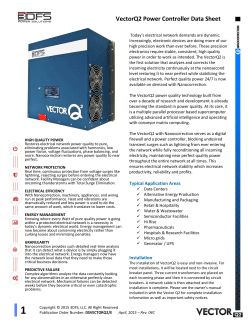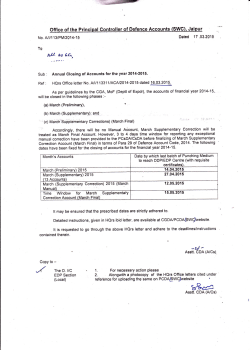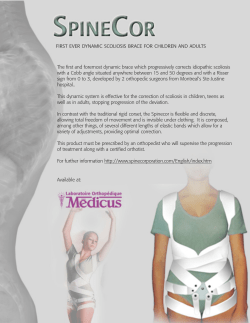
I. Purpose (DETAILED FACILITY CONDITION ASSESSMENT) VFA SAMPLE RFP
VFA SAMPLE RFP (DETAILED FACILITY CONDITION ASSESSMENT) I. Purpose As part of a strategic planning directive, the <client> has decided to undertake a comprehensive condition audit and plant capital renewal analysis. The purpose of this analysis is to ascertain (1) the present condition of the facilities, (2) whether the physical plant functionally meets the needs of the institution, and (3) what future funding and management programs are required to maintain the functional operations of the plant. In general, the collection, documentation and analysis of the audit data must enable the institution to do the following: 1. Identify the extent and severity of the deferred maintenance liability. 2. Identify, prioritize, and schedule deferred maintenance reduction projects that best take advantage of available funds and improve the functional aspects of the facilities. 3. Identify the resources needed to maintain the operability, suitability, and value of the 4. 5. 6. 7. 8. II. physical assets given their current function (i.e., the plant renewal investment requirement). Identify the building replacement costs and property/building condition indices. Identify what is necessary to adapt the selected facilities to meet the planned future requirements of the institution, the requirements of today’s standards and codes, and the needs of changing technology as it impacts space (i.e., plant adaptation). Develop a long-range comprehensive financial planning process that protects the value of the institution’s assets. Develop a tool that supports the institutional planning process by providing readily accessible facilities information for the <client’s> facilities decision making process. Maintain an up-to-date database that supports the above mentioned goals and enables an ongoing process to manage plant assets and their functional use. The system should leverage an inter / intra net structure with relational database technology and full analytical and decision support tools and methodologies. Overview <Client> is soliciting interest from firms to conduct a detailed condition assessment, perform a capital renewal analysis of its facilities, and install a web-based facility management system for use by <Client’s> facilities and management personnel. This computerized system will systematize maintenance and use facility condition and cost data that enables strategic capital reinvestment planning and the integration of physical assets. <Client’s> facilities are comprised of <#> buildings, totaling approximately <area> square feet. A specific listing of the facilities by area type, age and location are attached as Exhibit <X>. The <Client> may choose the option of undertaking a “Pilot” assessment prior to the entire condition assessment. In general, the objectives of the proposed project are the following: 1. Identify deficient conditions in terms of deferred maintenance, capital renewal and building and life safety code non-compliance issues. 2. Devise a method of correction for each deficient condition (corrective actions). 3. Classify and prioritize deficient conditions, associated corrective actions, and information concerning building systems and deficiency categories (cause or nature of deficiency). 4. Provide cost estimates for each correction of each project using published, industry standard construction, facilities maintenance and repair cost estimating data that reflects location and labor types as per the direction of <Client>. The cost estimating system shall be embedded within the overall software. The computerized system shall automate annual updating of correction costs based on changes to published construction costs. 5. Provide digital photographs integrated with the software tool to document individual buildings and each deficiency (as required) that will be associated with the physical assets. 6. Computerized system shall provide the ability to aggregate corrections into contract packages or bundles of projects for cost-effective contracting, purchasing, and correction. It shall enable the iterative analysis of various correction projects and bundling of approaches to analyze the most cost-effective approach for the work and integrate the full range of capital projects. 7. Establish a building component depreciation analysis to forecast renewal investment rates required to maintain facilities over time. Computerized system shall enable graphical reporting of renewal requirements for individual facilities or grouped facilities. 8. Provide multi-level financial modeling capabilities and the ability to benchmark facility conditions to like buildings. Systems should be capable of tracking and modeling for current as well as future situations. 9. Systems will have the ability to project and analyze costs for deferred maintenance and capital renewal. 10. Provide <X> user licenses for <X> sites of the computerized system. Install the computerized system, a web-based, relational database management program for the ongoing management and maintenance of said data by <Client’s> staff. The required hardware, as specified by the Consultant, will be purchased by the <Client: There will be an option for the <client> to use an Application Service Provider (ASP) model in which <the client> will pay a monthly usage fee for the software application and also receive comprehensive services in lieu of purchasing the hardware / software. As an ASP, the Consultant will be responsible for hosting the application and all data on its server, providing adequate bandwidth to support <X> concurrent users, and providing backup and continuous service, as well as software updates. 11. The web-based software shall utilize a standard relational database structure such as Oracle, or SQL Server. All must be ODBC compliant. The system shall be accessed through Microsoft Internet Explorer 4.0 or higher. Page 2 12. Provide training, documentation, upgrades, and support via telephone and email to licensed users for the installed computer system for a period of one year from installation date, with the option for extension. III. Scope of Services A. Facility Condition Survey This contract will require inspections of all facilities as specified herein by architectural and engineering professionals. It will produce an accurate analysis that identifies visible and discernable (through non-destructive means) components and elements requiring maintenance or other planned action. The facility conditions survey will focus on the following property elements: Exterior Systems - roofs, walls, window systems, doors Interior Construction - walls, doors, flooring, visible structural components Interior Finishes: Flooring, ceiling, wall finishes Health/Fire/Life Safety systems Handicap Accessibility - ADA & TLR requirements Heating, Ventilation and Air Conditioning Plumbing Electrical and Service Distribution Fire Suppression Special Electrical Systems, Emergency Power, Telecommunications Special Construction Vertical Transportation Optional elements include site utilities and site surface structures. B. Integration of Client-Supplied Facility Condition Data In addition to observed facilities deficiency conditions, existing client-supplied facility condition data shall be reviewed by the Consultant for possible incorporation into the facility database. The Consultant will review and conduct brief interviews with <Client> data managers to determine if the data is suitable and in electronic form, and to determine data integrity and completeness. This process may very well affect the time involved in carrying out the work. All client-supplied facility condition data shall be identified as such in the database. Other types of client-supplied data may include any of the following: prior engineering studies, hazardous materials audits, air or water quality studies, or other related facility condition data. Inclusion of existing client-supplied reports, electronic databases or spreadsheets, and other data needs to be considered on a case by case basis. Page 3 C. Corrections - Deficient Conditions For every deficient condition identified in the audit, a means of correcting the condition (a correction project) shall be developed. Each correction project shall entail a detailed description of the methods and quantities of labor and materials necessary to conduct the work. A detailed, multiple line item, construction estimate will also be developed. The estimates shall be based upon R.S.Means Construction and Facilities Maintenance and Repair Costs data and estimating format. Where appropriate, and at the direction of <Client>, multiple correction methodologies should be developed indicating the range of possible corrective measures and the associated costs. The computerized system shall enable toggling between multiple correction methodologies at users’ discretion. Each correction project shall be assigned a unique identifier within the computerized system and shall enable correction tracking by <Client> staff as deficiencies are corrected. D. Prioritization/Categorization/Classification of Audit Data Each correction project shall associate within the relational database technology the following three items from which multiple sorts, reports and analyses may be conducted: 1. Deficiency Priorities Each deficiency identified in the field audit shall be prioritized in the following manner: Priority 1 Currently Critical Conditions in this category require immediate action to: a. correct a cited safety hazard b. stop accelerated deterioration c. return a facility to operation Priority 2 Potentially Critical Conditions in this category, if not corrected expeditiously, will become critical within a year. Situations within this category include: a. intermittent operations b. rapid deterioration c. potential life safety hazards Priority 3 Necessary - Not yet critical Conditions in this category require appropriate attention to preclude predictable deterioration or potential downtime and the associated damage or higher costs if deferred further. Priority 4 Recommended Conditions in this category include items that represent a sensible improvement to existing conditions. These are not required for the most basic function of the facility; however, Priority 4 projects will Page 4 improve overall usability and/or reduce long-term maintenance costs. Priority 5 Does Not Meet Current Codes/Standards - “Grandfathered” Conditions in this category include items that do not conform to existing codes, but are “grandfathered” in their condition. No action is required at this time, but should substantial work be undertaken in contiguous areas, certain existing conditions may require correction. 2. Deficiency Categories Each correction project identified shall be assigned one of the following categories: Life-Safety Code Compliance Building Code Compliance Accessibility Code Compliance (ADA & <Client State> Accessibility Standards) Building Integrity Functionality Appearance Energy Environmental: (as provided in client-supplied facilities condition data) - ACBM (asbestos containing building materials) - PCBs - Lead-based paints - CFCs - IAQ (indoor air quality) - Water Quality The above categories represent sample definitions and may be revised to meet requirements of the <Client> through the initial stages of the audit process. 3. Classification Each deficiency shall be classified by the major property components identified for survey in the field. That is, each deficiency shall be either of the following classifications: Site; Exterior Systems; Interior Systems; Interior Finishes; Health/ Fire/Life Safety Systems; Handicap Accessibility; Heating, Ventilation and Air Conditioning; Plumbing; Electrical and Service Distribution; Special Electrical Systems; Fire Suppression, Special Construction, or Vertical Transportation. 4. User Specified Classifications In addition to the standard categories and classifications available within the software system, the <Client> should have the ability to edit support tables to allow for clientspecified classifications to be added to the above lists. Page 5 E. Targeting and Benchmarking Systems should be capable of targeting and benchmarking facilities and building condition and performance. Benchmarking of the facilities condition index should follow standard industry practices. F. Facility Renewal Calculations Identifying the rate of reinvestment required to maintain components of the plant as they degrade and become unusable is critical to the long-range planning and funding of the facilities. The consultant shall analyze and model the rates of degradation of each facility and report on the required reinvestment rate on an annual basis to replace components as such components become dysfunctional. Elements of the analysis will include: 1. Identification of the approximate replacement cost of each building and building component. 2. Rates of standard degradation of each component and the cost to replace/ refurbish that component. 3. Current condition of each building component. 4. The ability to analyze multi-year outlooks and various combinations of building type reinvestment rates. The systems should also be capable of generating multi-level financial modeling based on the deferred maintenance backlog, capital renewal and selected time frame. Systems should be capable of analyzing and projecting funding for time periods up to 100 years. G. Project Planning The system should provide the ability to create, track, and execute actual projects. The system will aggregate projects into contract packages or bundles of projects for more cost-effective contracting/purchasing/correction. In doing so, the system will enable the iterative analysis of various correction projects to analyze the most cost-effective approach for the work, giving the <client> the ability to develop logical and strategic deferred maintenance reduction plans and capital expenditure plans most appropriate to budget allocations. H. Deliverables The consultant shall provide the following deliverables: (Select all that are appropriate) ♦ <X> Copies of Pilot Report ♦ <X> Copies of Draft Report (for review/comment by client) to include: 1. Executive summary 2. Methodology description 3. Summary Reports of <X> different sorts and queries on data Page 6 4. Detailed Building and Deficiency Data 5. Appendices of <Client> data used ♦ <X> Copies of Final Report (contents similar to Draft Report) ♦ Database (unless ASP model) ♦ Software Media (CD ROM) with installation/setup instructions (unless ASP) ♦ <X> User manuals or Help Documentation within the Application ♦ Project Schedule ♦ Schedule of Values for Partial Progress Payments ♦ Meeting Minutes (if meetings are required) IV. Format of Qualifications Submission The consultant’s submittal should provide the following information: 1. Detailed descriptions of the management plan to be used to accomplish the work. Include the proposed methodology, the schedule, and the process to be used. List, categorize and submit samples of all deliverables. 2. Description of the firm and all proposed subcontractors’ major services and activities. Include information on the number of years in business, the type (corporation, partnership, sole proprietorship) number and location of offices. 3. Short description of recent projects that demonstrate successful performance conducting facilities condition surveys at institutions of equal complexity. Include three (3) references, with a contact name and phone number that <Client> may contact at each institution. It is preferred that references include those clients for whom the respondent has provided services similar in nature, quantity and quality to those requested in this RFP. 4. Resumes of the team members that will be assigned to the project. Resumes should demonstrate their education and recent experience performing similar services. Also, provide a project organizational chart and detail the experience of senior management and the support staff that will be used in this project. 5. Demonstration of the web-based software developed for performing the proposed work at <Client> facilities, following the initial review process by <Client>. V. Evaluation Criteria 1. Previous experience with facility condition analysis projects at other institutions of equal complexity and associated use of a proven, detailed assessment methodology. (25%) 2. Capabilities of the computerized system: performance; features (e.g., embedded RS Means data, use of a standard web browser, project bundling, funding Page 7 3. 4. 5. 6. VI. scenarios); ease-of-use; program for support and systems upgrades; ability to integrate with other <Client> systems. (25%) Overall experience in developing and successfully deploying like web-based solutions for similar-sized institutions. (20%) References from existing assessment clients and existing software system users. (10%) Overall quality of resumes of proposed team members performing the study, as well as the experience of senior management and support staff used for the project. (10%) Ability of the firm to perform the work within <X> weeks period of time. (10%) Proposal Offer Firm Responses to this RFP, including proposal prices, will be considered firm for ninety (90) days after the due date for receipt of proposals or sixty (60) days after receipt of a best and final offer, if one is submitted. VII. Disclosure of Proposal Contents The proposals will be kept confidential until a contract is awarded by the <client>. At that time, all proposals and documents pertaining to the proposals will be open to the public, except for the material that is proprietary or confidential. The <client> will not disclose or make public any pages of a proposal on which the offeror has stamped or imprinted “proprietary” or “confidential,” subject to the following requirements: Proprietary or confidential data shall be readily separable from the proposal to facilitate eventual public inspection of the non-confidential portion of the proposal. Confidential data is normally restricted to confidential financial information concerning the offeror’s organization and data that qualifies as a trade secret. If a request is received for disclosure of data for which an offeror has made a written request of confidentiality, the <client> shall examine the offeror’s request and make a written determination that specifies which portions of the proposals should be disclosed. Unless the offeror takes legal action to prevent the disclosure, the proposal will be so disclosed. The proposal shall be open to public inspection subject to any continuing prohibition on the disclosure of confidential data. VIII. Avoiding Conflicts of Interest Respondents to this RFP must be exclusively in the business of performing facility condition assessments and should not be a provider of construction, construction management or outsourced facility management services - specifically third party management of building portfolios. Contractor(s) and Subcontractors are required to agree, as a condition of receiving this contract, that they will not contract or subcontract to perform any construction or corrective work related to any facility assessment done by the contractor under this Page 8 contract for a period of 48 months. The purpose of this provision is to avoid any possibility that a person or entity involved in the assessments use that opportunity to profit from any corrective work resulting from the assessment, so as to avoid even the appearance of impropriety and the possibility that the assessment might be influenced by the hope of future related contracts. For the purpose of this section, the phrase “any construction or corrective work related to any assessment” shall include work of any sort, including but not limited to, consulting, planning, professional services and/or construction management for a period of two years. IX. Project Schedule 1. 2. 3. 4. RFP Issue Date Proposal response date Project award date Project completion date Page 9
© Copyright 2025















